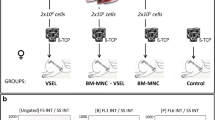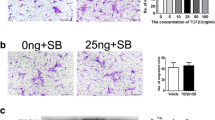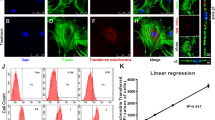Abstract
Introduction
Recent studies have indicated the potential of stem cell therapy in combination with cytokines to restore the bone repair via migration and homing of stem cells to the defected area. The present study aimed to investigate the mobilization and recruitment of mesenchymal stem cells (MSCs) in response to SDF-1.
Materials and Methods
Herein, the knockout rat model of the bone defect (BD) was treated with the induced membrane technique. Then, wild type Wistar rats and SDF-1-knockout rats were selected for the establishment of BD-induced membrane (BD-IM) models and bone-graft (BG) models. The number of MSCs was evaluated by flow cytometry, along with the expression pattern of the SDF-1/CXCR4 axis as well as osteogenic factors was identified by RT-qPCR and Western blot analyses. Finally, the MSC migration ability was assessed by the Transwell assay.
Results
Our data illustrated that in the induced membrane tissues, the number of MSCs among the BD-IM modeled rats was increased, whereas, a lower number was documented among BG modeled rats. Besides, we found that lentivirus-mediated over-expression of SDF-1 in BG modeled rats could activate the SDF-1/CXCR4 axis, mobilize MSCs into the defect area, and up-regulate the osteogenic proteins.
Conclusions
Collectively, our study speculated that up-regulation of SDF-1 promotes the mobilization and migration of MSCs through the activation of the SDF-1/CXCR4 signal pathway.








Similar content being viewed by others
References
Zhu W, Wang D, Xiong J, Liu J, You W, Huang J, Duan L, Chen J, Zeng Y (2015) Study on clinical application of nano-hydroxyapatite bone in bone defect repair. Artif Cells Nanomed Biotechnol 43:361–365
Wiese A, Pape HC (2010) Bone defects caused by high-energy injuries, bone loss, infected nonunions, and nonunions. Orthop Clin N Am 41:1–4 (table of contents)
Eskander R, Ji T, Wang Y, Sun K, Hoang BH, Guo W (2014) Can surgical management of bone metastases improve quality of life among women with gynecologic cancer? World J Surg Oncol 12:250
Xu N, Ye X, Wei D, Zhong J, Chen Y, Xu G, He D (2014) 3D artificial bones for bone repair prepared by computed tomography-guided fused deposition modeling for bone repair. ACS Appl Mater Interfaces 6:14952–14963
Auregan JC, Begue T (2014) Induced membrane for treatment of critical sized bone defect: a review of experimental and clinical experiences. Int Orthop 38:1971–1978
Kishi T, Karger C, Schneider L, Fitoussi F, Masquelet AC (2012) French Society of Orthopaedic S Traumatology. Treatment of posttraumatic bone defects by the induced membrane technique. Orthop Traumatol Surg Res 98:97–102
Marquez-Curtis LA, Janowska-Wieczorek A (2013) Enhancing the migration ability of mesenchymal stromal cells by targeting the SDF-1/CXCR4 axis. Biomed Res Int 2013:561098
Masyuk M, Brand-Saberi B (2015) Recruitment of skeletal muscle progenitors to secondary sites: a role for CXCR4/SDF-1 signalling in skeletal muscle development. Results Probl Cell Differ 56:1–23
Nagasawa T (2014) CXC chemokine ligand 12 (CXCL12) and its receptor CXCR4. J Mol Med (Berl) 92:433–439
Song F, Sun H, Huang L, Fu D, Huang C (2017) The role of Pannexin3-modified human dental pulp-derived mesenchymal stromal cells in repairing rat cranial critical-sized bone defects. Cell Physiol Biochem 44:2174–2188
Sensebe L, Krampera M, Schrezenmeier H, Bourin P, Giordano R (2010) Mesenchymal stem cells for clinical application. Vox Sang 98:93–107
Fakhari S, Kalantar E, Nikzaban M, Hakhamneshi MS, Fathi F, Nikkhoo B, Rahmani MR, Beiraghdar M, Jalili A (2014) Effect of Helicobacter pylori infection on stromal-derived factor-1/CXCR4 axis in bone marrow-derived mesenchymal stem cells. Adv Biomed Res 3:19
Wang Y, Sun X, Lv J, Zeng L, Wei X, Wei L (2017) Stromal cell-derived factor-1 accelerates cartilage defect repairing by recruiting bone marrow mesenchymal stem cells and promoting chondrogenic differentiation. Tissue Eng Part A 23:1160–1168
Okada K, Kawao N, Yano M, Tamura Y, Kurashimo S, Okumoto K, Kojima K, Kaji H (2016) Stromal cell-derived factor-1 mediates changes of bone marrow stem cells during the bone repair process. Am J Physiol Endocrinol Metab 310:E15–E23
Masquelet AC, Begue T (2010) The concept of induced membrane for reconstruction of long bone defects. Orthop Clin N Am 41:27–37 (table of contents)
Peng WX, Wang L (2017) Adenovirus-mediated expression of BMP-2 and BFGF in bone marrow mesenchymal stem cells combined with demineralized bone matrix for repair of femoral head osteonecrosis in beagle dogs. Cell Physiol Biochem 43:1648–1662
Spinelli O, Pagani IS, Mattarucchi E, Pirrone C, Pigni D et al (2014) Genomic quantitative real-time PCR proves residual disease positivity in more than 30% samples with negative mRNA-based qRT-PCR in chronic myeloid leukemia. Oncoscience 1:510–521
Hirbe AC, Morgan EA, Weilbaecher KN (2010) The CXCR4/SDF-1 chemokine axis: a potential therapeutic target for bone metastases? Curr Pharm Des 16:1284–1290
Ho CY, Sanghani A, Hua J, Coathup M, Kalia P, Blunn G (2015) Mesenchymal stem cells with increased stromal cell-derived factor 1 expression enhanced fracture healing. Tissue Eng Part A 21:594–602
Li C, Ding J, Jiang L, Shi C, Ni S, Jin H, Li D, Sun H (2014) Potential of mesenchymal stem cells by adenovirus-mediated erythropoietin gene therapy approaches for bone defect. Cell Biochem Biophys 70:1199–1204
Nabil I, Mehanna RA, Attia N, Bary AA, Razek KA, Ahmed TA, Elsayed F (2015) The effect of bone marrow-derived mesenchymal stem cells and their conditioned media topically delivered in fibrin glue on chronic wound healing in rats. Biomed Res Int 2015:846062
Osugi M, Katagiri W, Yoshimi R, Inukai T, Hibi H, Ueda M (2012) Conditioned media from mesenchymal stem cells enhanced bone regeneration in rat calvarial bone defects. Tissue Eng Part A 18:1479–1489
Mamillapalli R, Wang X, Mutlu L, Du H, Taylor HS (2015) Chemoattraction of bone marrow-derived stem cells towards human endometrial stromal cells is mediated by estradiol regulated CXCL12 and CXCR4 expression. Stem Cell Res 15:14–22
Sanghani A, Ho CY, Hua J, Coathup M, Kalia P, Blunn G (2015) Mesenchymal stem cells with increased stromal cell-derived factor 1 expression enhanced fracture healing. Tissue Eng Part A 21:594–602
Janowska-Wieczorek A, Marquez-Curtis LA (2013) Enhancing the migration ability of mesenchymal stromal cells by targeting the SDF-1/CXCR4 axis. Biomed Res Int 2013:561098
Giannobile W, Jin Q (2014) SDF-1 enhances wound healing of critical-sized calvarial defects beyond self-repair capacity. PLoS ONE 9:e97035
Wei Y, Shi J, Xia J, Wang S, Wu J et al (2014) CXCL12-CXCR4 contributes to the implication of bone marrow in cancer metastasis. Future Oncol 10:749–759
Pecina M, Dumic-Cule I, Jelic M, Jankolija M, Popek I, Grgurevic L, Vukicevic S (2015) Biological aspects of segmental bone defects management. Int Orthop 39:1005–1011
Nakazato R, Takarada T, Tsuchikane A, Fujikawa K, Iezaki T, Yoneda Y, Hinoi E (2016) Genetic analysis of Runx2 function during intramembranous ossification. Development 143:211–218
Messina A, De Fusco C, Monda V, Viggiano E, Moscatelli F et al (2017) Osteopontin: relation between adipose tissue and bone homeostasis. Stem Cells Int 2017:4045238
Frid M, Burke DL, Kunrath CL, Karoor V, Anwar A et al (2009) Sustained hypoxia promotes the development of a pulmonary artery-specific chronic inflammatory microenvironment. Am J Physiol Lung Cell Mol Physiol 297:L238–L250
Yuan K, Chen J, Mao X, Miano JM, Wu H, Chen Y (2012) Serum response factor regulates bone formation via IGF-1 and Runx2 signals. J Bone Miner Res 27:1659–1668
Wang L, Qin Y, Gao Z, Chen G, Zhang C (2016) Bone marrow stromal/stem cell-derived extracellular vesicles regulate osteoblast activity and differentiation in vitro and promote bone regeneration in vivo. Sci Rep 6:21961
Acknowledgements
We acknowledge and appreciate our colleagues for their valuable efforts and comments on this paper.
Funding
None.
Author information
Authors and Affiliations
Corresponding authors
Ethics declarations
Conflict of interest
All authors have no conflicts of interest.
Additional information
Publisher's Note
Springer Nature remains neutral with regard to jurisdictional claims in published maps and institutional affiliations.
About this article
Cite this article
Zhang, H., Li, X., Li, J. et al. SDF-1 mediates mesenchymal stem cell recruitment and migration via the SDF-1/CXCR4 axis in bone defect. J Bone Miner Metab 39, 126–138 (2021). https://doi.org/10.1007/s00774-020-01122-0
Received:
Accepted:
Published:
Issue Date:
DOI: https://doi.org/10.1007/s00774-020-01122-0




